Wei Cheng
Hierarchy-Aware Fine-Tuning of Vision-Language Models
Dec 25, 2025Abstract:Vision-Language Models (VLMs) learn powerful multimodal representations through large-scale image-text pretraining, but adapting them to hierarchical classification is underexplored. Standard approaches treat labels as flat categories and require full fine-tuning, which is expensive and produces inconsistent predictions across taxonomy levels. We propose an efficient hierarchy-aware fine-tuning framework that updates a few parameters while enforcing structural consistency. We combine two objectives: Tree-Path KL Divergence (TP-KL) aligns predictions along the ground-truth label path for vertical coherence, while Hierarchy-Sibling Smoothed Cross-Entropy (HiSCE) encourages consistent predictions among sibling classes. Both losses work in the VLM's shared embedding space and integrate with lightweight LoRA adaptation. Experiments across multiple benchmarks show consistent improvements in Full-Path Accuracy and Tree-based Inconsistency Error with minimal parameter overhead. Our approach provides an efficient strategy for adapting VLMs to structured taxonomies.
SkillGen: Learning Domain Skills for In-Context Sequential Decision Making
Nov 18, 2025Abstract:Large language models (LLMs) are increasingly applied to sequential decision-making through in-context learning (ICL), yet their effectiveness is highly sensitive to prompt quality. Effective prompts should meet three principles: focus on decision-critical information, provide step-level granularity, and minimize reliance on expert annotations through label efficiency. However, existing ICL methods often fail to satisfy all three criteria simultaneously. Motivated by these challenges, we introduce SkillGen, a skill-based ICL framework for structured sequential reasoning. It constructs an action-centric, domain-level graph from sampled trajectories, identifies high-utility actions via temporal-difference credit assignment, and retrieves step-wise skills to generate fine-grained, context-aware prompts. We further present a theoretical analysis showing that focusing on high-utility segments supports task identifiability and informs more effective ICL prompt design. Experiments on ALFWorld, BabyAI, and ScienceWorld, using both open-source and proprietary LLMs, show that SkillGen achieves consistent gains, improving progress rate by 5.9%-16.5% on average across models.
xTime: Extreme Event Prediction with Hierarchical Knowledge Distillation and Expert Fusion
Oct 23, 2025Abstract:Extreme events frequently occur in real-world time series and often carry significant practical implications. In domains such as climate and healthcare, these events, such as floods, heatwaves, or acute medical episodes, can lead to serious consequences. Accurate forecasting of such events is therefore of substantial importance. Most existing time series forecasting models are optimized for overall performance within the prediction window, but often struggle to accurately predict extreme events, such as high temperatures or heart rate spikes. The main challenges are data imbalance and the neglect of valuable information contained in intermediate events that precede extreme events. In this paper, we propose xTime, a novel framework for extreme event forecasting in time series. xTime leverages knowledge distillation to transfer information from models trained on lower-rarity events, thereby improving prediction performance on rarer ones. In addition, we introduce a mixture of experts (MoE) mechanism that dynamically selects and fuses outputs from expert models across different rarity levels, which further improves the forecasting performance for extreme events. Experiments on multiple datasets show that xTime achieves consistent improvements, with forecasting accuracy on extreme events improving from 3% to 78%.
WithAnyone: Towards Controllable and ID Consistent Image Generation
Oct 16, 2025Abstract:Identity-consistent generation has become an important focus in text-to-image research, with recent models achieving notable success in producing images aligned with a reference identity. Yet, the scarcity of large-scale paired datasets containing multiple images of the same individual forces most approaches to adopt reconstruction-based training. This reliance often leads to a failure mode we term copy-paste, where the model directly replicates the reference face rather than preserving identity across natural variations in pose, expression, or lighting. Such over-similarity undermines controllability and limits the expressive power of generation. To address these limitations, we (1) construct a large-scale paired dataset MultiID-2M, tailored for multi-person scenarios, providing diverse references for each identity; (2) introduce a benchmark that quantifies both copy-paste artifacts and the trade-off between identity fidelity and variation; and (3) propose a novel training paradigm with a contrastive identity loss that leverages paired data to balance fidelity with diversity. These contributions culminate in WithAnyone, a diffusion-based model that effectively mitigates copy-paste while preserving high identity similarity. Extensive qualitative and quantitative experiments demonstrate that WithAnyone significantly reduces copy-paste artifacts, improves controllability over pose and expression, and maintains strong perceptual quality. User studies further validate that our method achieves high identity fidelity while enabling expressive controllable generation.
DeepSieve: Information Sieving via LLM-as-a-Knowledge-Router
Jul 30, 2025Abstract:Large Language Models (LLMs) excel at many reasoning tasks but struggle with knowledge-intensive queries due to their inability to dynamically access up-to-date or domain-specific information. Retrieval-Augmented Generation (RAG) has emerged as a promising solution, enabling LLMs to ground their responses in external sources. However, existing RAG methods lack fine-grained control over both the query and source sides, often resulting in noisy retrieval and shallow reasoning. In this work, we introduce DeepSieve, an agentic RAG framework that incorporates information sieving via LLM-as-a-knowledge-router. DeepSieve decomposes complex queries into structured sub-questions and recursively routes each to the most suitable knowledge source, filtering irrelevant information through a multi-stage distillation process. Our design emphasizes modularity, transparency, and adaptability, leveraging recent advances in agentic system design. Experiments on multi-hop QA tasks across heterogeneous sources demonstrate improved reasoning depth, retrieval precision, and interpretability over conventional RAG approaches. Our codes are available at https://github.com/MinghoKwok/DeepSieve.
OneIG-Bench: Omni-dimensional Nuanced Evaluation for Image Generation
Jun 09, 2025Abstract:Text-to-image (T2I) models have garnered significant attention for generating high-quality images aligned with text prompts. However, rapid T2I model advancements reveal limitations in early benchmarks, lacking comprehensive evaluations, for example, the evaluation on reasoning, text rendering and style. Notably, recent state-of-the-art models, with their rich knowledge modeling capabilities, show promising results on the image generation problems requiring strong reasoning ability, yet existing evaluation systems have not adequately addressed this frontier. To systematically address these gaps, we introduce OneIG-Bench, a meticulously designed comprehensive benchmark framework for fine-grained evaluation of T2I models across multiple dimensions, including prompt-image alignment, text rendering precision, reasoning-generated content, stylization, and diversity. By structuring the evaluation, this benchmark enables in-depth analysis of model performance, helping researchers and practitioners pinpoint strengths and bottlenecks in the full pipeline of image generation. Specifically, OneIG-Bench enables flexible evaluation by allowing users to focus on a particular evaluation subset. Instead of generating images for the entire set of prompts, users can generate images only for the prompts associated with the selected dimension and complete the corresponding evaluation accordingly. Our codebase and dataset are now publicly available to facilitate reproducible evaluation studies and cross-model comparisons within the T2I research community.
ViStoryBench: Comprehensive Benchmark Suite for Story Visualization
May 30, 2025Abstract:Story visualization, which aims to generate a sequence of visually coherent images aligning with a given narrative and reference images, has seen significant progress with recent advancements in generative models. To further enhance the performance of story visualization frameworks in real-world scenarios, we introduce a comprehensive evaluation benchmark, ViStoryBench. We collect a diverse dataset encompassing various story types and artistic styles, ensuring models are evaluated across multiple dimensions such as different plots (e.g., comedy, horror) and visual aesthetics (e.g., anime, 3D renderings). ViStoryBench is carefully curated to balance narrative structures and visual elements, featuring stories with single and multiple protagonists to test models' ability to maintain character consistency. Additionally, it includes complex plots and intricate world-building to challenge models in generating accurate visuals. To ensure comprehensive comparisons, our benchmark incorporates a wide range of evaluation metrics assessing critical aspects. This structured and multifaceted framework enables researchers to thoroughly identify both the strengths and weaknesses of different models, fostering targeted improvements.
Multi-Modal View Enhanced Large Vision Models for Long-Term Time Series Forecasting
May 29, 2025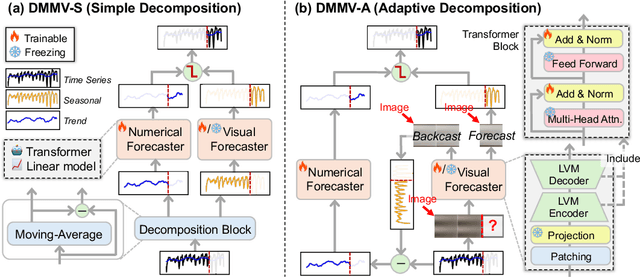
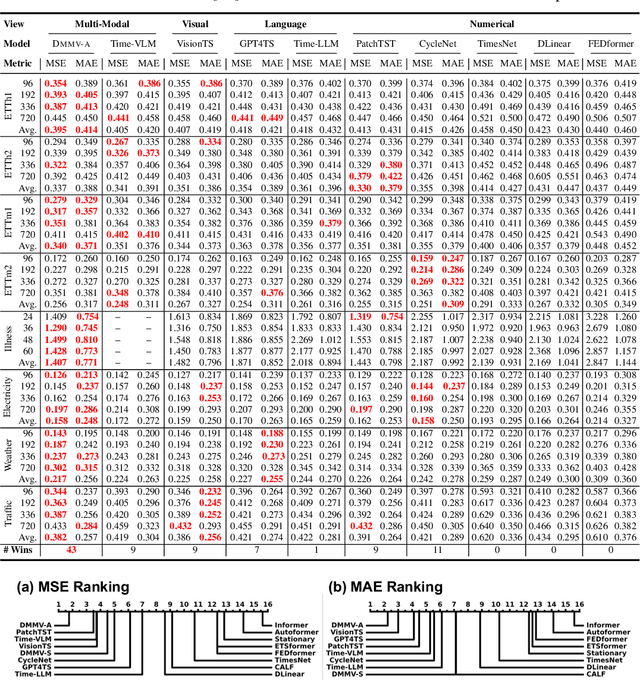
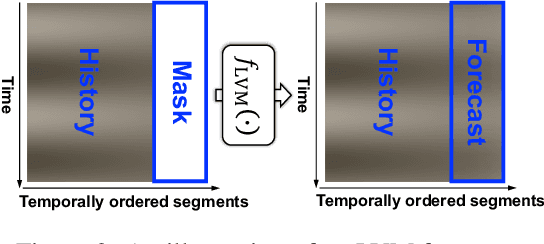
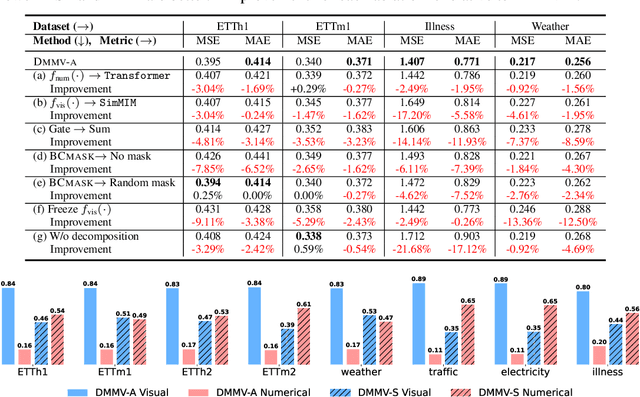
Abstract:Time series, typically represented as numerical sequences, can also be transformed into images and texts, offering multi-modal views (MMVs) of the same underlying signal. These MMVs can reveal complementary patterns and enable the use of powerful pre-trained large models, such as large vision models (LVMs), for long-term time series forecasting (LTSF). However, as we identified in this work, applying LVMs to LTSF poses an inductive bias towards "forecasting periods". To harness this bias, we propose DMMV, a novel decomposition-based multi-modal view framework that leverages trend-seasonal decomposition and a novel backcast residual based adaptive decomposition to integrate MMVs for LTSF. Comparative evaluations against 14 state-of-the-art (SOTA) models across diverse datasets show that DMMV outperforms single-view and existing multi-modal baselines, achieving the best mean squared error (MSE) on 6 out of 8 benchmark datasets.
LM$^2$otifs : An Explainable Framework for Machine-Generated Texts Detection
May 18, 2025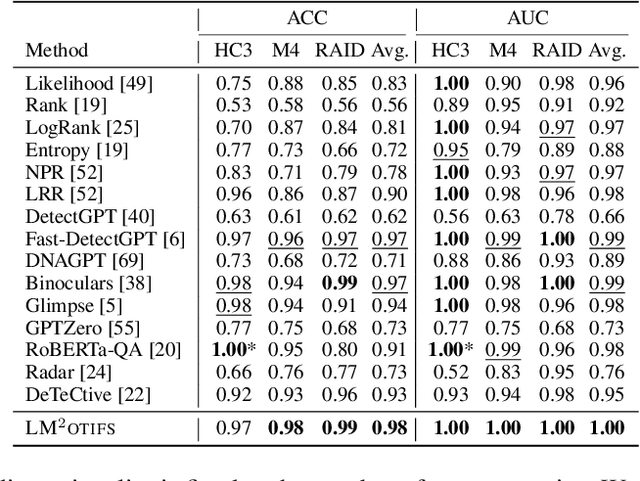

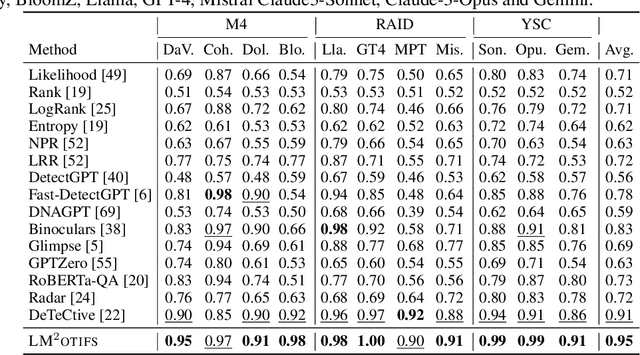
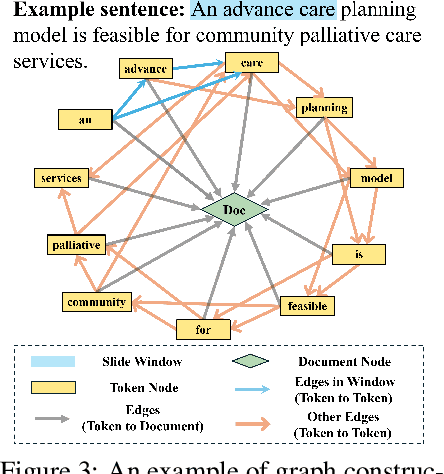
Abstract:The impressive ability of large language models to generate natural text across various tasks has led to critical challenges in authorship authentication. Although numerous detection methods have been developed to differentiate between machine-generated texts (MGT) and human-generated texts (HGT), the explainability of these methods remains a significant gap. Traditional explainability techniques often fall short in capturing the complex word relationships that distinguish HGT from MGT. To address this limitation, we present LM$^2$otifs, a novel explainable framework for MGT detection. Inspired by probabilistic graphical models, we provide a theoretical rationale for the effectiveness. LM$^2$otifs utilizes eXplainable Graph Neural Networks to achieve both accurate detection and interpretability. The LM$^2$otifs pipeline operates in three key stages: first, it transforms text into graphs based on word co-occurrence to represent lexical dependencies; second, graph neural networks are used for prediction; and third, a post-hoc explainability method extracts interpretable motifs, offering multi-level explanations from individual words to sentence structures. Extensive experiments on multiple benchmark datasets demonstrate the comparable performance of LM$^2$otifs. The empirical evaluation of the extracted explainable motifs confirms their effectiveness in differentiating HGT and MGT. Furthermore, qualitative analysis reveals distinct and visible linguistic fingerprints characteristic of MGT.
Step1X-3D: Towards High-Fidelity and Controllable Generation of Textured 3D Assets
May 12, 2025Abstract:While generative artificial intelligence has advanced significantly across text, image, audio, and video domains, 3D generation remains comparatively underdeveloped due to fundamental challenges such as data scarcity, algorithmic limitations, and ecosystem fragmentation. To this end, we present Step1X-3D, an open framework addressing these challenges through: (1) a rigorous data curation pipeline processing >5M assets to create a 2M high-quality dataset with standardized geometric and textural properties; (2) a two-stage 3D-native architecture combining a hybrid VAE-DiT geometry generator with an diffusion-based texture synthesis module; and (3) the full open-source release of models, training code, and adaptation modules. For geometry generation, the hybrid VAE-DiT component produces TSDF representations by employing perceiver-based latent encoding with sharp edge sampling for detail preservation. The diffusion-based texture synthesis module then ensures cross-view consistency through geometric conditioning and latent-space synchronization. Benchmark results demonstrate state-of-the-art performance that exceeds existing open-source methods, while also achieving competitive quality with proprietary solutions. Notably, the framework uniquely bridges the 2D and 3D generation paradigms by supporting direct transfer of 2D control techniques~(e.g., LoRA) to 3D synthesis. By simultaneously advancing data quality, algorithmic fidelity, and reproducibility, Step1X-3D aims to establish new standards for open research in controllable 3D asset generation.
 Add to Chrome
Add to Chrome Add to Firefox
Add to Firefox Add to Edge
Add to Edge